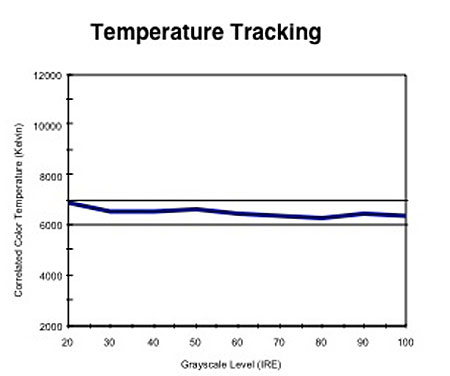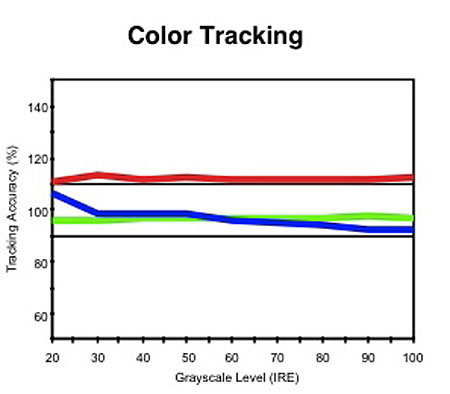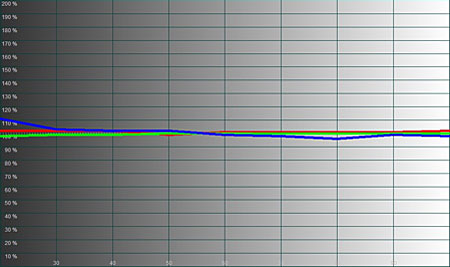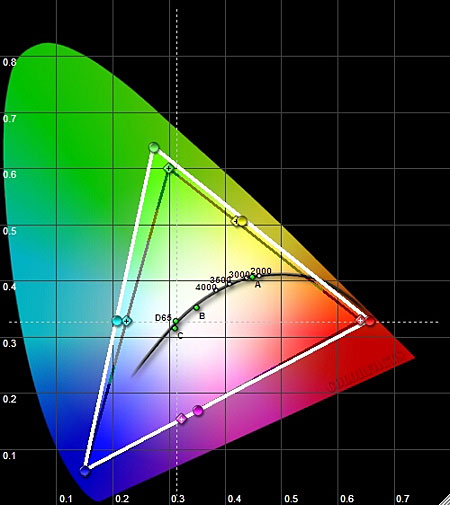Pioneer KURO PDP-5080HD 50" Plasma Display Measurements and Settings
I did notice one oddity when attempting to set the black level using a PLUGE pattern such as the one on the Digital Video Essentials DVD. When I raised the black levels so that I could see all three PLUGE bars to start the setup, the below black bar had a glowing white halo all around it—much like the corona in a full solar eclipse. I saw it both with Pioneer's new BDP-94HD and Samsung's BD-P1200 Blu-ray players—though it was more pronounced on the BDP-94HD.
The color temperature, out of the box, measured a fairly uniform 6000K in Low (Fig.1) and about 7900K in Medium (slightly lower than that at the top end of the brightness range, slightly higher at the low end).

Fig.1
After calibration (Fig.2) the results were definitely improved. While the color temperature calibration adjustments in the service menu (there are none in the user menus apart from the Low, Mid, and High settings) offer control over the low and high-end in the usual red, green, and blue, Pioneer strongly warned me to avoid using the low-end adjustments. With just a single set of adjustments, I could not correct the top end dip seen in the After results without raising the low-end temperature too high.

Fig.2
Nevertheless, the calibrated result was far closer to the desired 6500K than before—and closer also to D6500, the precise point on the color chart that we are aiming for in a calibration. Figs. 3 and 4 show the red, green, and blue balance before and after calibration. The closer the lines overlap at 100%, the closer the result is to D6500.

Fig.3

Fig.4
The Pioneer's color points were more than acceptable (Fig.5), but as with most sets they were not absolutely correct. As you can see, blue was nearly a perfect match to the ATSC standard, red was just a bit deeper than ideal, and green was oversaturated—though far less than we usually see. The secondary points were good, though not perfect. Yellow was the nearest to the standard.

Fig.5
In Movie mode, the set's component resolution at 1080i was good to 18.5MHz but deeply rolled off (though still visible) at 37.1MHz. At 720p, component, the response was good to 18.5MHz but poor at 37.1MHz, with no luminance resolution lines visible in the bursts at that higher frequency.
Over HDMI, the 1080i response was good at 18.5MHz but slightly rolled off at 37.5MHz. But it was notably poorer in Standard mode than the other picture modes. At 720p, HDMI, the response was flawless at 18.5MHz but missing in action (no resolution lines visible at all) at 37.1MHz. The 37.1MHz 720p response improved slightly, to fair, in the User mode.
The set's overscan averaged approximately 1.5% at either 720p or 1080i, using both component and HDMI. It was somewhat higher in 480i/p: 3% in HDMI and averaging approximately 4% in component (about 3% left and right, 5% top and bottom). These readings were consistent across all picture modes. There is no user accessible overscan adjustment.
I measured a peak contrast ratio of 5,014:1 (40.11 foot-Lamberts peak white, 0.008fL video black) with a peak white window pattern.
Because of their peak power requirements, all plasmas reduce their outputs progressively as the average picture brightness of the source increases. With a full field peak white image rather than a window pattern, the peak contrast ratio of the Pioneer dropped to 1,698:1 (13.58fL peak white, 0.008fL video black).
I measured an ANSI contrast ratio, using the standard 16 square checkerboard, of 2,600:1. That's not a misprint with an added zero. Amazingly, the black squares on the ANSI pattern ranged from 0.006 to 0.009fL—nearly the same as the full-field black. While you'll never see an ANSI contrast this good in a real room even with the lights off, it's still the most impressive ANSI contrast measurement I've yet measured on a display personally.
Settings
Keep in mind that unit-to-unit sample variations, the viewing environment, and the source might render these settings less than optimum. We strongly recommend that you confirm the results on your sample by using one of the many display setup DVDs that are available, such as Digital Video Essentials.
Mode: Movie
Contrast: 39
Brightness: 0
Color: 0
Tint: 0
Sharpness: -13
Pure Cinema: Standard
Picture Detail: Off
DRE: Off
Black Level: Off
ACL: Off
Enhancer Mode: 2
Gamma: 2 or 1
Color Temperature (before calibration): Low
Color Temperature (after calibration): Mid
CTI: Off
3DNR: Off
Field NR: Off
- Log in or register to post comments














































